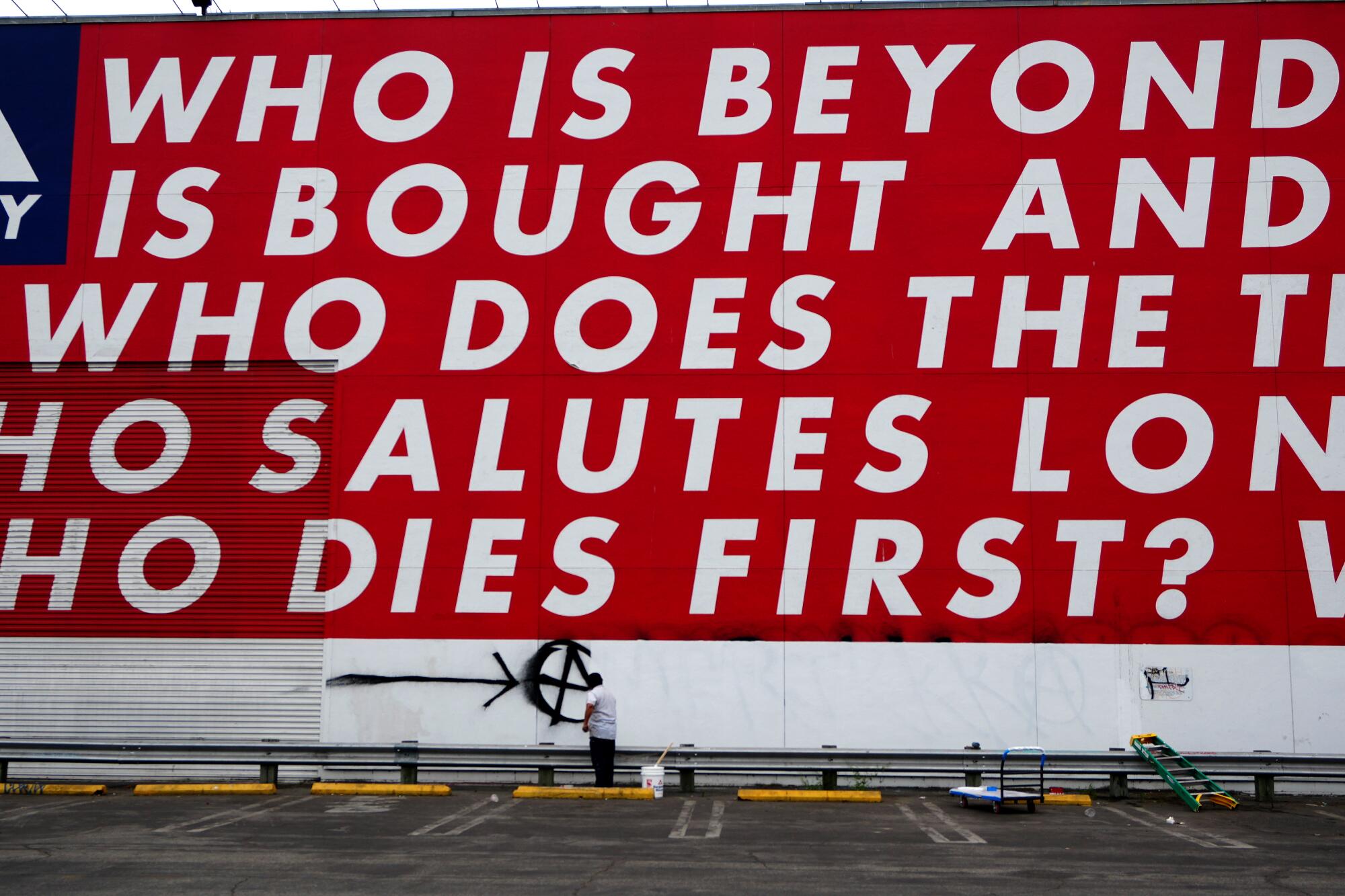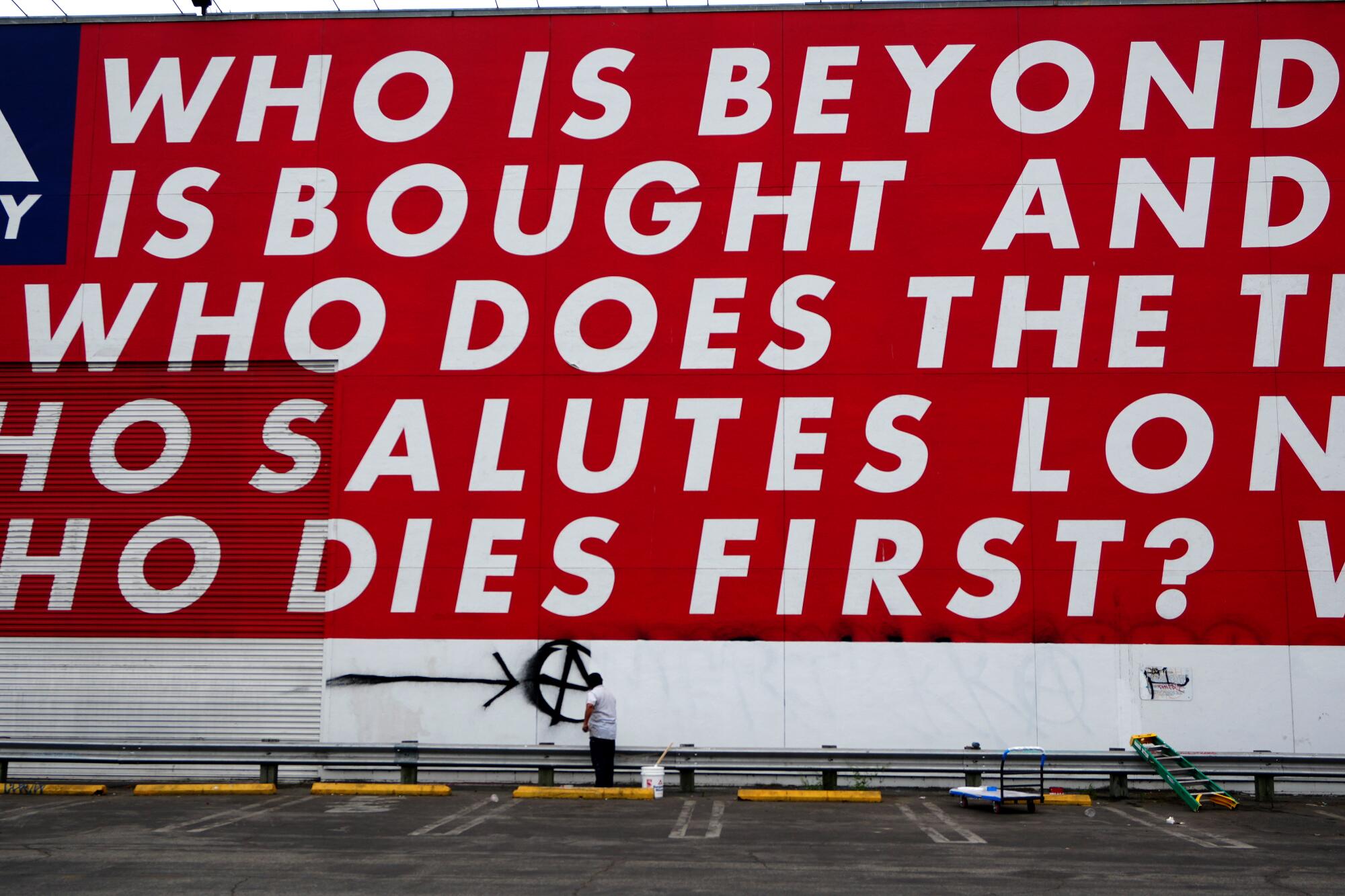As protesters swarmed downtown Los Angeles to denounce ICE raids in their communities and the deployment of the National Guard, a potent image kept flashing across television screens and social media: officers in riot gear facing off against flag- and sign-waving demonstrators in front of a strikingly resonant, red mural posing a series of queries interrogating the very nature of power and control.
Barbara Kruger’s 30-by-191-foot “Questions” takes up the entire side wall of the Museum of Contemporary Art’s Geffen Contemporary warehouse building, facing Temple Street and — notably — the Edward R. Roybal Federal Building. Like many of Kruger’s most iconic images, including her famous 1989 abortion rights poster, “Your Body Is a Battleground,” the mural features words in starkly clear graphic design — in this case, white letters on a red background asking nine now-prophetic questions:
“Who is beyond the law? Who is bought and sold? Who is free to choose? Who does the time? Who follows orders? Who salutes longest? Who prays loudest? Who dies first? Who laughs last?”
The mural was commissioned in 1990 by former MOCA curator Ann Goldstein, who is now at the the Art Institute of Chicago.
Former MOCA Chief Curator Paul Schimmel posted a TV screenshot of protesters in front of the mural on Sunday with the caption, “#Barbara Krugers #moca mural doing its art job as the riots against #ice consume LA.”
Reached for comment Monday, Schimmel added that Kruger “understood the importance and power of a mural facing the then-new Federal Building. Multiple generations of MOCA staff have brought it back to life because of its profundity.”
Kruger, a longtime L.A. resident, responded Monday to The Times’ request for comment about the mural’s immersion in this fraught moment of city history, writing via email: “This provocation is giving Trump what he wants: the moment he can declare martial law. As if that’s not already in play.”
In a YouTube video posted to MOCA’s website when the museum reinstalled the mural in 2018, Kruger says: “There was a very visible wall on the side of this building, and it was an opportunity to make a statement about pride and prominence and power and control and fear. The questions were always the important part of the work.”
At another point in the video, she adds: “One would hope that in the 30 years since, things would have changed a bit. And things have changed. For the good and for the bad, and for everything in between.”
Images of “Questions” abound on social media, including on X, where a few users recognized the significance of the art behind the protesters. Misinformation has been rampant on social media, and one post showed a photo of a masked individual creeping below the mural with the claim that the person “broke into the MOCA Museum and destroyed everything.”
A MOCA representative debunked that claim Monday, saying that the museum closed early, at about 1:30 p.m. Sunday, “out of an abundance of caution and for the safety and well-being of our staff and visitors,” and that it expected to open again, per its normal operating hours, on Thursday. The museum is always closed Monday through Wednesday.
The only damage to the Geffen Contemporary was some graffiti that the museum said could be removed.

Cleanup continues after a night of protests in downtown Los Angeles on June 9, 2025.
(Damian Dovarganes / Associated Press)
Adding a hyper-meta art moment, MOCA’s current durational performance, “Police State” by Pussy Riot frontwoman Nadya Tolokonnikova, continued until 6 p.m. inside the building, just without its usual live audience. The performance consists of Tolokonnikova sitting at a bare wooden table inside of a corrugated steel structure resembling a Russian prison cell.
Tolokonnikova, who spent two years in a Russian prison following a performance in Moscow’s Cathedral of Christ the Saviour, spent those hours Sunday broadcasting live audio of the protests outside mixed with her own heartbeat to the empty museum.
“Police State Exhibit Is Closed Due To The Police State,” she wrote in a post on X.
“Durational performance is a scary thing to step into: once you said you’re going to show up, you can’t just leave simply because of the National Guard had a whim to occupy the city, so my choice was to stay and continue doing my job as an artist,” she said in a statement.
